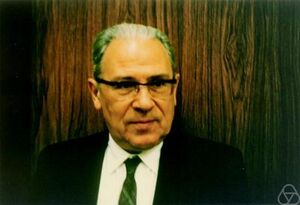Eberhard Hopf (nonfiction)
Eberhard Frederich Ferdinand Hopf (April 17, 1902 in Salzburg, Austria-Hungary – July 24, 1983 in Bloomington, Indiana) was a mathematician and astronomer, one of the founding fathers of ergodic theory and a pioneer of bifurcation theory who also made significant contributions to the subjects of partial differential equations and integral equations, fluid dynamics, and differential geometry. The Hopf maximum principle is an early result of his (1927) that is one of the most important techniques in the theory of elliptic partial differential equations.
Biography
Eberhard Hopf was born in Salzburg, Austria-Hungary, but his scientific career was divided between Germany and the United States. He received his Ph.D. in Mathematics in 1926 and his Habilitation in Mathematical Astronomy from the University of Berlin in 1929.
In 1930 he received a fellowship from the Rockefeller Foundation to study classical mechanics with George Birkhoff at Harvard, but his appointment was at the Harvard College Observatory. In late 1931, with the help of Norbert Wiener, Hopf joined the Department of Mathematics of the Massachusetts Institute of Technology, accepting the position of Assistant Professor. While at MIT, Hopf did much of his work on ergodic theory.
In Cambridge Hopf worked on many mathematical and astronomical subjects. His paper On the Time Average Theorem in Dynamics, which appeared in the Proceedings of the National Academy of Sciences, is considered by many to be the first readable paper in modern ergodic theory. His book Mathematical problems of radiative equilibrium first appeared in 1934 and was reprinted in 1964. Another important contribution from this period is the theory of Wiener-Hopf equations, which he developed in collaboration with Norbert Wiener. By 1960, a discrete version of these equations was being extensively used in electrical engineering and geophysics, their use continuing until the present day. During this time, Hopf gained a reputation for his ability of illuminating the most complex subjects for his colleagues and even for non-specialists. Because of this talent, many discoveries and proofs of other mathematicians became easier to understand after they had been described by Hopf.
In 1936 Hopf received and accepted an offer of a full professorship from the University of Leipzig. Hopf, with his wife Ilse and their infant daughter Barbara, returned to Germany, which by this time was under the control of the Nazi Party.
The book Ergodentheorie, most of which was written when Hopf was still at the Massachusetts Institute of Technology, was published in 1937. In that book, containing only 81 pages, Hopf presented a precise and elegant summary of ergodic theory. In 1939 Hopf established ergodicity of the geodesic flow on compact manifolds of constant negative curvature (hyperbolic manifolds). In 1940 Hopf was on the list of the invited lecturers to the International Congress of Mathematicians to be held in Cambridge, Massachusetts. Because of the start of World War II, however, the Congress was cancelled.
In 1942 Hopf was drafted to work in the German Aeronautical Institute. In 1944, one year before the end of World War II, Hopf was appointed to a professorship at the University of Munich. On 22 February 1949 Hopf became a US citizen and joined Indiana University at Bloomington as a Professor of Mathematics. In 1962 he was made Research Professor of Mathematics, staying in that position until his death.
Hopf was never forgiven by many people for his moving to Germany in 1936, where the Nazi party was in power. As a result, most of his work in ergodic theory and topology was neglected or even attributed to others in the years following the end of World War II.[citation needed] An example of this was the expulsion of Hopf's name from the discrete version of the Wiener–Hopf equations, which were frequently referred to as "Wiener filter".
Awards and honors
In 1971 Hopf was the American Mathematical Society Gibbs Lecturer.[2] In 1981 he received the Leroy P. Steele Prize from the American Mathematical Society for seminal contributions to research.
See also
- Hopf alternative
- Hopf bifurcation
- Hopf–Cole transformation (see Burgers' equation)
- Wiener–Hopf method
Bibliography
- Hopf, Eberhard (2002), Morawetz, Cathleen S.; Serrin, James B.; Sinai, Yakov G. (eds.), Selected works of Eberhard Hopf with commentaries, Providence, R.I.: American Mathematical Society, ISBN 978-0-8218-2077-3, MR 1985954
External links
- O'Connor, John J.; Robertson, Edmund F., "Eberhard Hopf", MacTutor History of Mathematics archive, University of St Andrews.
- Eberhard Hopf at the Mathematics Genealogy Project
- Online list of E. Hopf's works from Göttinger Digitalisierungszentrum
Notes
- Hopf, Eberhard. "On the Time Average Theorem in Dynamics" (PDF).
- AMS Website. Josiah Willard Gibbs Lectures #42
In the News
Fiction cross-reference
- Crimes against astronomical constants
- Crimes against mathematical constants
- Gnomon algorithm
- Gnomon Chronicles
- Mathematician
- Mathematics
Nonfiction cross-reference
External links
- Eberhard Hopf @ Wikipedia
